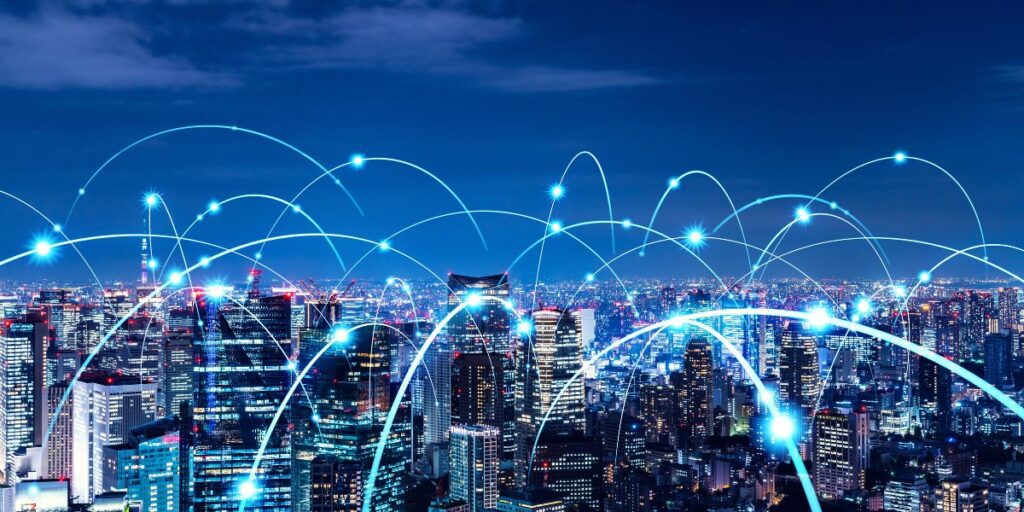As the global rollout of 5G technology continues to accelerate in 2025, its impact is becoming increasingly evident across various industries. Offering faster data transfer speeds, lower latency, and more reliable connections, 5G is poised to revolutionize the way we connect and interact with the world around us. From healthcare and manufacturing to entertainment and smart cities, 5G is opening up new possibilities for innovation and connectivity that were previously unimaginable. This article explores the potential of 5G in reshaping industries, enabling the growth of the Internet of Things (IoT), and fostering advancements in technologies like autonomous vehicles, augmented reality, and remote healthcare.
Faster Data Transfer and Its Impact on Key Industries
One of the most significant benefits of 5G is its ability to offer faster data transfer speeds compared to previous generations of wireless technology. With speeds up to 100 times faster than 4G, 5G enables real-time communication and the seamless transfer of large amounts of data. This has profound implications for industries that rely on data-heavy applications, such as healthcare, manufacturing, and entertainment.
In healthcare, 5G’s high-speed capabilities are enabling innovations like remote surgeries and real-time patient monitoring. Surgeons can now use augmented reality (AR) and virtual reality (VR) tools in real-time, guided by high-quality video feeds and data, to perform complex procedures from miles away. Additionally, wearable devices that collect patient data can transmit information instantly to doctors, allowing for faster diagnoses and more personalized care. This capability is critical for remote healthcare, particularly in rural areas or regions with limited access to healthcare professionals.
In manufacturing, 5G is facilitating the growth of smart factories, where machines, robots, and human workers are interconnected through real-time communication. High-speed data transfer allows for faster production processes, predictive maintenance of machinery, and more efficient inventory management. With 5G, manufacturers can harness the full potential of the Internet of Things (IoT), creating more efficient and adaptable supply chains.
The Growth of IoT: Connecting Everything
5G’s ability to support a higher density of connected devices is fueling the expansion of the Internet of Things (IoT), which has the potential to transform nearly every aspect of daily life. In cities, homes, and industries, more devices than ever are connected to the internet, enabling smarter systems that communicate with one another.
In smart cities, 5G is the backbone of intelligent infrastructure, powering everything from traffic management systems to waste collection and energy distribution. Sensors embedded in roads, traffic lights, and buildings collect data that can be transmitted instantly, helping cities operate more efficiently and sustainably. With 5G, cities can process this vast amount of data in real-time, making it possible to reduce congestion, improve public transportation, and lower energy consumption, all while enhancing residents’ quality of life.
At the consumer level, IoT-powered smart homes are becoming more sophisticated with 5G. Smart thermostats, security systems, appliances, and even healthcare devices can now communicate seamlessly, providing enhanced convenience, security, and energy efficiency. With 5G, these devices can also respond faster and more accurately to user commands, creating a more seamless and intuitive experience for consumers.
Advancements in Autonomous Vehicles
The development of autonomous vehicles is one of the most exciting applications of 5G technology. Self-driving cars and trucks rely on the rapid exchange of data between the vehicle, infrastructure, and other connected vehicles to make real-time decisions. 5G’s ultra-low latency and high-speed capabilities are critical for the success of autonomous vehicles, allowing them to react to changing road conditions, traffic signals, and obstacles in fractions of a second.
With 5G, autonomous vehicles can communicate with each other and with smart infrastructure, enabling safer and more efficient driving. This technology could also improve traffic flow by allowing vehicles to coordinate movements in real-time, reducing congestion and fuel consumption. As 5G networks become more widespread, the vision of fully autonomous transportation systems may become a reality sooner than expected, leading to a significant shift in the way goods and people are transported.
Augmented Reality: A New Era of Immersive Experiences
In entertainment and education, 5G is paving the way for more immersive and interactive experiences through augmented reality (AR) and virtual reality (VR). With its high-speed, low-latency capabilities, 5G makes it possible to stream AR and VR content in real-time without significant lag or interruptions. This opens up new opportunities for everything from gaming to virtual tourism to online learning.
In gaming, 5G will enable cloud-based gaming platforms to stream high-definition games directly to devices without the need for expensive consoles or hardware. AR applications, such as interactive shopping experiences or virtual home design tools, will become more responsive, providing users with real-time interactions and visualizations. Additionally, the ability to support large-scale AR events, such as concerts or sports games, in real-time is opening up new ways for fans to engage with their favorite events.
Remote Healthcare: Revolutionizing Patient Care
5G is also playing a crucial role in the evolution of remote healthcare. With the ability to transmit large volumes of data quickly and securely, 5G is enabling doctors to monitor patients remotely, conduct virtual consultations, and even perform robotic-assisted surgeries. Patients with chronic conditions or those in underserved areas can access healthcare services without the need to travel long distances, making healthcare more accessible to everyone.
In emergency medical services, 5G can provide real-time video and data transfer from the scene of an accident or emergency to doctors and hospitals, allowing for faster and more informed decision-making. For rural areas, this technology can eliminate geographical barriers, providing patients with access to specialist care that may not otherwise be available.
The Future of 5G: Unlocking New Possibilities
As 5G technology continues to roll out globally in 2025, its potential to transform industries is just beginning to be realized. Faster data transfer, the expansion of IoT, and advancements in autonomous vehicles, augmented reality, and remote healthcare are just the beginning. In the coming years, 5G will drive innovation in ways we can’t yet fully imagine, from enhancing personal connectivity to enabling entirely new industries. While challenges remain in terms of infrastructure and accessibility, the future of connectivity and innovation is undeniably bright with 5G at the helm.


